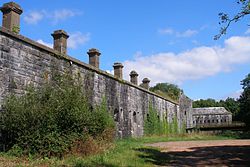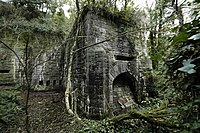Scraesdon Fort
| Scraesdon Fort | |
|
Cornwall | |
|---|---|
 Scraesdon Fort | |
| Type: | Palmerston fort |
| Location | |
| Grid reference: | SX391548 |
| Location: | 50°22’19"N, 4°15’46"W |
| Village: | Antony |
| History | |
| Information | |
| Condition: | derelict |
| Owned by: | The Crown |
Scraesdon Fort stands near the village of Antony on the Rame Peninsula in the very south-east of Cornwall. It formed part of the ring of forts built in Cornwall and Devon surrounding Plymouth, to protect Plymouth Sound, and, in particular Plymouth docks, from enemy naval attack.
The Plymouth forts were built as a result of a decision in Lord Palmerston's premiership to deter the French from attacking naval bases in the south.
Construction and history

Scraesdon Fort was designed in 1859 at a cost of £137,000. It is constructed in the Land Front, polygonal, near octagonal format. It has a dry ditch, and was designed to have twenty-seven 7-inch breech-loading guns on the ramparts,[1] although only eight were ever mounted.
The upper level is 254 feet above mean sea level and the lower level 173 feet.
The fort was used by the Ministry of Defence as a training barracks, but it is currently empty, derelict and overgrown. It was used to train Royal Navy Artificer Apprentices from two shore establishments, HMS Fisgard and HMS Raleigh and it is occasionally used now by Royal Marine Commando recruits as part of their final exercise, as well as being used by local Army Reserve units. The fort is also used for airsoft events on an ad hoc basis.
Railway
A military railway connected the fort with the River Lynher at Wacker Quay, near St Germans. It also provided a link to the main fort on the Rame peninsula at Fort Tregantle. The railway was used from 1893 to 1903.
The railway ran underneath the metal bridge and down a gradient, then went underneath the current A374 road, and alongside Wacker Quay.
The locomotive shed was extant on the quayside until the first years of the twenty-first century, when it was removed by the council, who had been using it as a highways depot. Other remnants of the railway can also be seen. There was also an extensive marshalling area next to the east wall.

Outside links
- Victorian Forts data sheet: Scraesdon
- Images of England — details from listed building database (61670) Scraesdon Fort